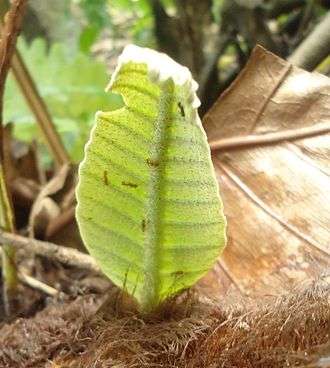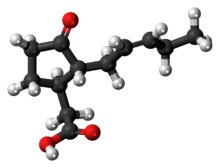Tritrophic interactions in plant defense

Tritrophic interactions as they relate to plant defense against herbivory describe the ecological impacts of three trophic levels on each other: the plant, the herbivore, and its natural enemies, predators of the herbivore. They may also be called multitrophic interactions when further trophic levels, such as hyperparasitoids or higher-order predators, are considered.[1] Tritrophic interactions join pollination and seed dispersal as vital biological functions which plants perform via cooperation with animals.[2]
Predators, pathogens, and parasitoids that attack plant-feeding insects, called natural enemies in a tritrophic context, can benefit plants by removing or hindering the feeding behavior of the harmful insect. It is thought that many plant traits have evolved in response to this mutualism to make themselves more attractive to natural enemies, and so the enlisting of natural enemies to protect against excessive herbivory is considered an indirect plant defense mechanism.[2] Traits attractive to natural enemies can be physical, in the case of flower structure and color patterns, or chemical, in the case of induced plant volatile chemicals used by natural enemies to pinpoint a food source.
Chemical mechanisms of enemy attraction
Plants universally produce secondary metabolites, also called allelochemicals, which serve no purpose in basic metabolic processes. Instead they persist because they mediate the interactions between a plant and its environment,[3][4] often attracting, repelling, or poisoning insects. In a tritrophic system, volatiles, which readily escape from plants into the air, are superior to surface chemicals in drawing foraging natural enemies from afar. Root volatiles also exist, driving tritrophic interactions among below-ground herbivores and their natural enemies.[5] A very small fraction of plant volatiles are detectable by humans, giving plants like basil, eucalyptus, and pine trees their distinctive odors.[1] The mixture and ratios of individual volatiles emitted by a plant under given circumstances is referred to as a volatile profile. These are highly specific to the plant species and detectable within several meters of the source. Predators and, more commonly, parasitoids exploit the specificity of volatile profiles to navigate the complex infochemical signals presented by plants in their efforts to locate a particular prey species.[1]
The production of volatiles is likely to be beneficial to a plant as long as they are effective in inviting visitation by natural enemies and as long as those natural enemies are effective in removing or impeding herbivores. However, volatile chemicals may not have evolved initially for this purpose, but for within-plant signaling,[6] to attract pollinators,[7] or to repel herbivores that dislike such odors.[1]
Induced defenses

When plants continuously release a baseline level of volatiles, these defenses are said to be constitutive. Upon an instance of herbivory, however, the plant may respond by considerably increasing its production of volatiles or by producing a new profile of volatiles. This plasticity is controlled by either the jasmonic acid pathway or the salicylic acid pathway, depending largely on the herbivore; these substances are often called herbivore-induced plant volatiles (HIPVs).[1][8] Though volatiles of any kind have an attractive effect on natural enemies, this effect is stronger for damaged plants than for undamaged plants,[1] perhaps because induced volatiles signal definitive and recent herbivore activity. The phenomenon of inducibility gives rise to the idea that plants are sending out a "distress call" to the third trophic level in times of herbivore attack.
Natural enemies can distinguish between mechanical tissue damage, which might occur during a number of events other than herbivory, and damage that is the direct result of insect feeding behavior. The presence of herbivore saliva or regurgitant mediates this differentiation and the resulting chemical pathway leads to a significantly stronger natural enemy response than mechanical damage could.[9][10][11][12] The reliability of HIPVs in broadcasting the location of prey means that for many foraging enemies, induced plant volatiles are more attractive than even the odors emitted by the prey insect itself.[13]
Local and systemic signals
When herbivores trigger an inducible chemical defense pathway, the resulting HIPVs may be emitted from the site of feeding damage (local induction), or from undamaged tissues belonging to a damaged plant (systemic induction). For example, when an herbivore feeds on a single corn seedling leaf, the plant will emit volatiles from all its leaves, whether or not they too have been damaged. Locally induced defenses aid parasitoids in targeting their foraging behaviors to the exact location of the herbivore on the plant. Systemic defenses are less spatially specific and may serve to confuse the enemy once the source plant is located. A plant might employ both local and systemic responses simultaneously.[1]
Morphological mechanisms of enemy attraction
Domatia

Natural enemies must survive long enough and respond quickly enough to plant volatiles in order to benefit the plant through predatory behavior. Certain plant structures, called domatia, can selectively reinforce mutualisms with natural enemies and increase the fitness benefit they receive from that mutualism by ensuring the survival and proximity of natural enemies. Domatia provide a kind of housing or refuge for predators from both abiotic stressors, such as desiccation, and biotic stress, such as predation from higher-order predators. Therefore they ensure not only better survival, but eliminate the time required for natural enemies to locate and travel to the damaged plant. For this reason, natural enemies that make use of domatia are often said to serve as "bodyguards" for the plant in or on which they live. Domatia may be as well-developed as acacia tree thorns, or as simple and incidental as a depression or crevice in a leaf stem, but they are distinguishable from galls and other similar structures in that they are not induced by the insect but formed constitutively by the plant.[1]
Nutritional rewards
As long as natural enemies have some potential to be omnivorous, plants can provide food resources to encourage their retention and increase the impact they have on herbivore populations. This potential, however, can hinge on a number of insect traits. For example, hemipteran predators can use their piercing-sucking mouthparts to make use of leaves, stems, and fruits, but spiders with chelicerae cannot.[1] Still, insects widely considered to be 100% carnivorous have recently been observed to diverge from expected feeding behavior.[14] Some plants simply tolerate a low level of herbivory by natural enemies for the service they provide in ridding the plant of more serious herbivores. Others, however, have structures thought to serve no purpose other than attracting and provisioning natural enemies. These are an outcome of a long history of coevolution between the first and third trophic levels. A good example are the extrafloral nectaries which many myrmecophytes and other angiosperms sport on leaves, bracts, stems, and fruits. Nutritionally, these are similar to floral nectaries but do not encourage the visiting insect to come into contact with pollen at any point. Their existence is therefore not the product of a pollinator-plant mutualism, but of a tritrophic, defensive interaction.[1]
Human uses
Exploitation of tritrophic interactions has the capacity to directly benefit agricultural systems. Significant biocontrol of crop pests can be exerted by the third trophic level, given an adequate population of natural enemies.[16][17] The widespread use of pesticides or Bt crops can undermine natural enemies’ success.[18][19][20] In some cases entire populations of predators and parasitoids are decimated, necessitating even greater use of insecticide because the ecological service they provided in controlling herbivores has been lost.
Even when pesticides are not widely used, monocultures cannot support natural enemies in great enough numbers for them to have any impact on pest populations. A lack of diversity in the first trophic level is usually linked to low abundance in the third because alternative resources are missing from the system that are necessary for stable, large natural enemy populations. Enemy diets can be subsidized by increasing landscape diversity through companion planting, border crops, cover crops, intercropping, or allowing some weed growth.[15] When nectar or other sugar-rich resources are provided, the natural enemy population thrives.[21]
References
- 1 2 3 4 5 6 7 8 9 10 Price, Peter W. (2011). Insect Ecology : Behavior, Populations and Communities (4th ed.). Cambridge: Cambridge University Press. ISBN 978-0-521-83488-9.
- 1 2 Heil, Martin (2008). "Indirect defence via tritrophic interactions". New Phytologist. 178 (1): 41–61. doi:10.1111/j.1469-8137.2007.02330.x. PMID 18086230.
- ↑ Fraenkel, G. S. (29 May 1959). "The Raison d'Etre of Secondary Plant Substances: These odd chemicals arose as a means of protecting plants from insects and now guide insects to food". Science. 129 (3361): 1466–1470. doi:10.1126/science.129.3361.1466. PMID 13658975.
- ↑ Whittaker, R. H.; Feeny, P. P. (26 February 1971). "Allelochemics: Chemical Interactions between Species". Science. 171 (3973): 757–770. doi:10.1126/science.171.3973.757.
- ↑ Rasmann, Sergio; Köllner, Tobias G.; Degenhardt, Jörg; Hiltpold, Ivan; Toepfer, Stefan; Kuhlmann, Ulrich; Gershenzon, Jonathan; Turlings, Ted C. J. (7 April 2005). "Recruitment of entomopathogenic nematodes by insect-damaged maize roots". Nature. 434 (7034): 732–737. doi:10.1038/nature03451.
- ↑ Frost, Christopher J.; Appel, Heidi M.; Carlson, John E.; De Moraes, Consuelo M.; Mescher, Mark C.; Schultz, Jack C. "Within-plant signalling via volatiles overcomes vascular constraints on systemic signalling and primes responses against herbivores". Ecology Letters. 10 (6): 490–498. doi:10.1111/j.1461-0248.2007.01043.x. Cite uses deprecated parameter
|coauthors=(help) - ↑ Kessler, D.; Gase, K.; Baldwin, I. T. (29 August 2008). "Field Experiments with Transformed Plants Reveal the Sense of Floral Scents". Science. 321 (5893): 1200–1202. doi:10.1126/science.1160072.
- ↑ Karban, Richard. "The ecology and evolution of induced resistance against herbivores". Functional Ecology. 25 (2): 339–347. doi:10.1111/j.1365-2435.2010.01789.x.
- ↑ Turlings, T. C. J.; Tumlinson, J. H.; Lewis, W. J. (30 November 1990). "Exploitation of Herbivore-Induced Plant Odors by Host-Seeking Parasitic Wasps". Science. 250 (4985): 1251–1253. doi:10.1126/science.250.4985.1251.
- ↑ Mattiacci, Letizia; Dicke, Marcel; Posthumus, Maarten A. "Induction of parasitoid attracting synomone in brussels sprouts plants by feeding ofPieris brassicae larvae: Role of mechanical damage and herbivore elicitor". Journal of Chemical Ecology. 20 (9): 2229–2247. doi:10.1007/BF02033199.
- ↑ Halitschke, R.; Keßler, A.; Kahl, J.; Lorenz, A.; Baldwin, I. T. (23 August 2000). "Ecophysiological comparison of direct and indirect defenses in Nicotiana attenuata". Oecologia. 124 (3): 408–417. doi:10.1007/s004420000389.
- ↑ Röse, Ursula S. R.; Tumlinson, James H. (22 April 2005). "Systemic induction of volatile release in cotton: How specific is the signal to herbivory?". Planta. 222 (2): 327–335. doi:10.1007/s00425-005-1528-2.
- ↑ Steinberg, Shimon; Dicke, Marcel; Vet, Louise E. M. "Relative importance of infochemicals from first and second trophic level in long-range host location by the larval parasitoidCotesia glomerata". Journal of Chemical Ecology. 19 (1): 47–59. doi:10.1007/BF00987470.
- ↑ Rubinoff, D. (22 July 2005). "Web-Spinning Caterpillar Stalks Snails". Science. 309 (5734): 575–575. doi:10.1126/science.1110397. PMID 16040699.
- 1 2 Landis, Douglas A.; Wratten, Stephen D.; Gurr, Geoff M. "Habitat Management to Conserve Natural Enemies of Arthropod Pests in Agriculture". Annual Review of Entomology. 45 (1): 175–201. doi:10.1146/annurev.ento.45.1.175.
- ↑ Bottrell, Dale G.; Barbosa, Pedro; Gould, Fred. "Manipulating Natural Enemies By Plant Variety Selection and Modification: A Realistic Strategy?". Annual Review of Entomology. 43 (1): 347–367. doi:10.1146/annurev.ento.43.1.347.
- ↑ Cortesero, A.M.; Stapel, J.O.; Lewis, W.J. "Understanding and Manipulating Plant Attributes to Enhance Biological Control". Biological Control. 17 (1): 35–49. doi:10.1006/bcon.1999.0777.
- ↑ Obrycki, John J. "Transgenic Insecticidal Corn: Beyond Insecticidal Toxicity to Ecological Complexity Analysis of transgenic insecticidal corn developed for lepidopteran pests reveals that the potential benefits of crop genetic engineering for insect pest management may not outweigh the potential ecological and economic risks". Oxford Journals. 51 (5): 353–361. doi:10.1641/0006-3568(2001)051[0353:TICBIT]2.0.CO;2.
- ↑ Groot, Astrid T.; Dicke, Marcel. "Insect-resistant transgenic plants in a multi-trophic context". The Plant Journal. 31 (4): 387–406. doi:10.1046/j.1365-313X.2002.01366.x.
- ↑ Poppy, Guy M.; Sutherland, Jamie P. "Can biological control benefit from genetically-modified crops? Tritrophic interactions on insect-resistant transgenic plants". Physiological Entomology. 29 (3): 257–268. doi:10.1111/j.0307-6962.2004.00382.x.
- ↑ Wäckers, edited by F.L.; Rijn, P.C.J. van; Bruin, J. (2005). Plant-provided food for carnivorous insects : protective mutualism and its applications (1. paperback ed.). New York: Cambridge University Press. ISBN 0521819415.